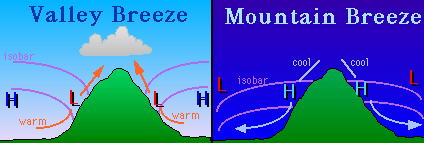|
|
Mountain-Valley BreezesA similar pattern occurs along mountain slopes. As the sun rises, the valley air warms rapidly and rises along the mountain slope to form the valley breeze. At night, the surface air quickly cools and slides down the mountain slope, forming the mountain breeze. The depth of the mountain breeze layer is usually quite shallow - often just a few 10's of meters deep. However, the speeds of mountain breezes are much higher than those of valley breezes, especially near the mouths of mountain valleys. Although this is due to the terrain of the mountains, it is, technically speaking, thermally driven. These, like the sea and lake breezes, are examples of mesoscale thermal circulations.
 Confused? Have a question? If so, check out the Frequently Asked Questions (FAQ) page or send mail to the OS411 tutor (os411tutor@shodor.org) with your question! Report technical/content problems here |
|
|